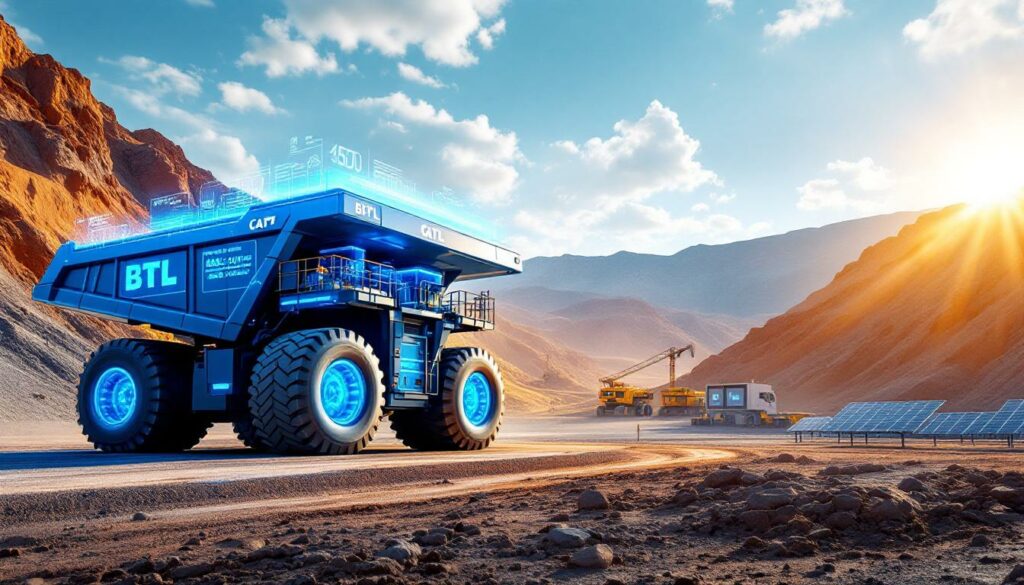What is the BHP-CATL Partnership?
In a significant move toward sustainable mining, BHP, one of the world's largest mining companies, has signed a strategic Memorandum of Understanding (MOU) with Contemporary Amperex Technology Co. Limited (CATL), a global leader in battery technology. This partnership represents a convergence of two industry titans, each bringing unique capabilities to address one of mining's greatest challenges: decarbonization through electrification.
The partnership specifically targets the development of battery solutions for mining operations, with a clear focus on reducing Scope 1 and 2 greenhouse gas emissions. This collaboration aligns with BHP's ambitious goal of achieving net zero operational emissions by 2050, positioning both companies at the forefront of the global energy transition insights landscape.
Understanding the Strategic Memorandum of Understanding
The recently signed MOU establishes a framework for cooperation between BHP and CATL across several key areas of innovation. According to the published agreement, the partnership will focus on:
- Developing specialized batteries for mining equipment and locomotives
- Creating rapid charging infrastructure tailored to mining environments
- Implementing energy storage systems at mining sites
- Advancing battery recycling options and processes
This strategic alliance represents more than a typical supplier relationship—it's a collaborative approach to technological co-development that addresses mining-specific challenges.
"CATL is a global leader in advanced battery technology, energy storage solutions, and battery recycling and is a natural partner for BHP," stated Rashpal Bhatti, BHP Group Procurement Officer, highlighting the complementary expertise both organizations bring to the table.
The partnership reflects BHP's recognition that achieving its sustainability goals requires innovation beyond its traditional capabilities, particularly in specialized battery technology.
Key Players in the Partnership
BHP enters this collaboration as a mining industry leader with operations spanning multiple continents and commodities. The company has increasingly prioritized sustainability initiatives while seeking technological solutions to reduce its environmental footprint. BHP brings deep operational knowledge of mining environments and requirements, along with significant copper resources that play a crucial role in battery manufacturing and recycling.
CATL contributes as one of the world's foremost battery technology innovators, with expertise spanning battery chemistry, energy storage systems, and recycling processes. As China's largest automotive lithium-ion battery manufacturer, CATL has established itself as a pioneer in developing high-performance, durable battery solutions for demanding applications.
Tan Libin, CATL's Head of Overseas Business, expressed the company's vision: "Together with forward-thinking resources companies like BHP, we aim to demonstrate how advanced battery technologies can decarbonise mining operations."
The executive perspectives from both companies emphasize that this partnership isn't merely about supplier relationships but about co-developing technologies specifically designed for mining's unique challenges.
Why Are Mining Companies Investing in Battery Technology?
Mining operations have traditionally relied heavily on diesel-powered equipment, contributing significantly to the industry's carbon footprint. The shift toward battery technology represents both an environmental imperative and a strategic business decision for forward-thinking mining companies.
The Decarbonization Imperative in Mining
The mining sector faces increasing pressure from multiple stakeholders to reduce its environmental impact. Investors, regulators, customers, and communities are all demanding more sustainable practices from extractive industries. This pressure has transformed decarbonization from a peripheral concern to a core business imperative.
Mining operations generate substantial Scope 1 emissions (direct emissions from owned or controlled sources) through diesel-powered vehicles, equipment, and on-site power generation. Scope 2 emissions (indirect emissions from purchased electricity) are also significant, particularly at remote operations relying on diesel generators or coal-powered electricity.
Key challenges in mining decarbonization include:
- Remote locations: Many mining operations are situated far from power grids
- Heavy equipment requirements: Mining vehicles often operate continuously under extreme loads
- Harsh environmental conditions: Equipment must withstand dust, vibration, and temperature extremes
- 24/7 operational demands: Battery solutions must support continuous operations
The BHP-CATL partnership explicitly acknowledges these challenges, with Bhatti noting the company is "recognising the need for innovative solutions to tackle Scope 1 and 2 emissions."
Battery Technology as a Game-Changer
Battery technology offers multiple pathways to transform mining operations beyond simple emissions reduction. The potential benefits include:
Emissions reduction: Electric equipment produces zero direct emissions, dramatically reducing a mine's carbon footprint. A single large haul truck conversion from diesel to electric can eliminate thousands of tons of CO₂ annually.
Operational efficiency: Electric motors deliver instantaneous torque and higher efficiency than diesel engines, potentially improving productivity in various mining applications.
Maintenance advantages: Electric systems typically have fewer moving parts than diesel equivalents, potentially reducing maintenance requirements and downtime.
Heat reduction: Battery-electric equipment generates significantly less heat than diesel alternatives, reducing ventilation requirements in underground mines—a major energy cost center.
Noise reduction: Electric equipment operates more quietly, improving working conditions and potentially enabling operations in noise-sensitive areas.
CATL's involvement brings cutting-edge battery technology expertise that can address mining-specific challenges, such as rapid charging capabilities and energy density requirements for heavy equipment. The partnership aims to accelerate adoption by developing purpose-built solutions rather than adapting existing technologies.
What Specific Technologies Will the Partnership Develop?
The BHP-CATL collaboration will focus on developing several critical technologies specifically engineered for mining applications. These developments represent more than simply adapting existing battery solutions—they require fundamental innovations to meet mining's unique operational demands.
Battery Solutions for Heavy Mining Equipment
Mining equipment presents unique challenges for battery technology. Heavy machinery such as haul trucks, excavators, loaders, and drills operate under extreme conditions while requiring substantial power. The partnership will focus on developing battery systems that can deliver:
- High power density: Mining equipment requires batteries that can deliver substantial power while maintaining reasonable size and weight parameters
- Extended cycle life: Batteries must withstand thousands of charge-discharge cycles under demanding conditions
- Extreme temperature performance: Mining operations span from arctic to desert environments, requiring batteries that function reliably across wide temperature ranges
- Vibration and shock resistance: Mining equipment experiences constant vibration and occasional impacts that conventional batteries aren't designed to withstand
- Dust and moisture protection: Battery systems need robust sealing against environmental contaminants
These specialized battery solutions will likely require custom chemistries, thermal management systems, and structural designs specific to mining applications rather than repurposed automotive batteries.
The partnership aims to create battery systems that deliver comparable or superior performance to diesel alternatives while reducing environmental impact and potentially offering operational advantages.
Rapid Charging Infrastructure Innovations
Developing high-capacity batteries is only part of the electrification equation. Mining operations require specialized charging infrastructure that can:
- Deliver high-power charging to minimize equipment downtime
- Function reliably in remote locations with challenging environmental conditions
- Integrate with existing mine power systems, including renewable energy sources
- Scale to support fleets of various electric mining equipment
- Maintain safety standards in potentially hazardous environments
The BHP-CATL partnership will explore charging solutions that address these unique requirements, potentially including:
- Modular, transportable charging stations for evolving mine sites
- Battery swap systems for large equipment
- Smart charging management to optimize power usage and grid interaction
- Ruggedized connectors and interfaces designed for mining environments
These charging innovations are crucial to making electrification practical in mining contexts where equipment utilization directly impacts operational economics.
Energy Storage Systems for Mining Applications
Beyond powering mobile equipment, the partnership will develop stationary energy storage systems that can:
- Balance load demands across mining operations, reducing peak power requirements
- Enable renewable integration by storing energy from solar or wind generation for use during production peaks
- Provide backup power for critical systems during outages
- Support micro-grid functionality at remote mining locations
- Optimize energy costs through time-of-use management
These energy storage systems will need to be scalable, durable, and capable of functioning reliably in mining environments that often present extreme temperature ranges, dust, and vibration.
CATL's expertise in grid-scale storage solutions provides a foundation for developing mining-specific systems that can help BHP optimize energy usage across its operations while supporting renewable energy integration.
How Will This Partnership Advance the Circular Economy?
A significant aspect of the BHP-CATL collaboration extends beyond immediate operational improvements to address the full lifecycle of battery technologies. This approach aligns with circular economy principles, where materials are kept in productive use rather than following a traditional take-make-dispose model.
Battery Recycling Initiatives
The partnership explicitly includes a focus on battery recycling breakthrough options, recognizing that sustainable electrification requires addressing end-of-life considerations for battery systems. This focus provides multiple benefits:
- Material recovery: Reclaiming valuable metals like lithium, cobalt, nickel, and copper from spent batteries
- Waste reduction: Minimizing disposal requirements for depleted battery systems
- Supply security: Creating secondary sources for critical battery materials
- Environmental impact reduction: Lessening the need for virgin material extraction
BHP's copper operations provide particularly relevant expertise and infrastructure for battery recycling processes. Copper plays a crucial role in battery systems and recycling processes, creating natural synergies between mining operations and battery recovery.
The collaboration aims to develop specialized recycling processes that address mining-specific battery designs, which may differ significantly from consumer or automotive applications in chemistry, structure, and scale.
"We are excited to work with BHP to advance the circular economy by enhancing battery recycling processes," noted Tan Libin from CATL, highlighting the importance of this aspect of the partnership.
By developing closed-loop systems, the partnership could establish new benchmarks for resource efficiency in industrial battery applications.
Sustainable Value Chain Development
Beyond recycling, the BHP-CATL partnership aims to develop more environmentally responsible approaches across the entire battery value chain:
- Responsible sourcing: Establishing transparent, ethical supply chains for battery materials
- Manufacturing efficiency: Reducing waste and energy consumption in battery production
- Lifecycle optimization: Designing battery systems for maximum operational life and eventual recyclability
- Second-life applications: Exploring opportunities to repurpose mining batteries for less demanding applications when they no longer meet primary performance requirements
This comprehensive approach aligns with broader industry trends toward increased transparency and sustainability throughout supply chains. By establishing clear frameworks for sustainable battery lifecycles in mining applications, the partnership could set industry standards that extend well beyond their immediate operations.
The collaboration leverages complementary strengths: BHP's position as a supplier of critical battery materials like copper and nickel, combined with CATL's expertise in battery design, manufacturing, and recycling technologies.
What Impact Will This Have on the Mining Industry?
The BHP-CATL partnership represents more than a single company initiative—it signals a potential inflection point for mining industry practices. By developing specialized solutions for mining electrification, this collaboration could accelerate adoption across the sector and establish new operational benchmarks.
Transforming Operational Efficiency
Battery-electric systems offer several potential efficiency advantages over traditional diesel equipment:
- Energy efficiency: Electric motors typically convert 85-90% of stored energy to mechanical work, compared to 30-40% for diesel engines
- Maintenance reduction: Electric systems have fewer moving parts and fluid requirements, potentially reducing maintenance frequency and complexity
- Operational simplification: Electrified systems can offer more precise control and simplified operation
- Performance improvements: Electric motors deliver maximum torque from zero RPM, potentially improving equipment performance in certain applications
While the initial focus may be on environmental benefits, these operational advantages could provide significant economic incentives for adoption. As battery-electric mining equipment matures, these efficiency gains could translate to measurable cost advantages.
The partnership's emphasis on mining-specific solutions addresses a crucial barrier to adoption: the need for purpose-built systems rather than adapted technologies from other sectors. By developing equipment tailored to mining's unique requirements, the initiative could accelerate industry-wide implementation.
Environmental Performance Improvements
Electrification represents one of the most substantial opportunities for powering Australia's mines to reduce their environmental footprint:
- Direct emissions elimination: Battery-electric equipment produces zero tailpipe emissions
- Noise reduction: Electric equipment operates more quietly than diesel alternatives
- Heat reduction: Less waste heat generation reduces ventilation requirements in underground operations
- Local air quality improvement: Elimination of diesel particulates and other combustion byproducts
- Potential for renewable integration: Electric systems can utilize renewable energy sources, unlike diesel equipment
These environmental benefits extend beyond carbon reduction to address multiple aspects of mining's impact. The comprehensive approach could significantly improve mining's social license to operate in environmentally sensitive regions.
The BHP-CATL partnership specifically targets the achievement of net zero operational greenhouse gas emissions (Scope 1 and 2) by 2050, providing a clear long-term objective for their technological developments.
Setting New Industry Standards
As industry leaders, BHP and CATL have the potential to establish de facto standards for mining electrification through this partnership:
- Technical specifications: Defining performance requirements for mining battery systems
- Safety protocols: Establishing best practices for battery operation in mining environments
- Charging infrastructure: Developing standardized approaches to charging and energy management
- Lifecycle management: Creating frameworks for responsible battery deployment through end-of-life
Early adoption of advanced technologies could provide significant competitive advantages, including regulatory compliance positioning, operational cost optimization, and enhanced social license to operate.
The partnership's comprehensive approach—addressing equipment, infrastructure, energy storage, and recycling—creates a template for holistic transformation rather than incremental improvement.
What Challenges Must Be Overcome?
Despite the promising potential, the path to mining electrification faces substantial challenges that the BHP-CATL partnership must address to achieve widespread adoption and meaningful impact.
Technical Hurdles in Mining Electrification
Mining environments impose extreme demands on equipment and systems, creating several technical challenges for battery electrification:
- Power density requirements: Mining equipment requires substantial energy to move large volumes of material, challenging current battery energy density limitations
- Duty cycle demands: Mining operations often run continuously (24/7), requiring battery systems that can support extended operation through fast charging or swap systems
- Environmental extremes: Battery systems must function reliably in temperatures ranging from sub-zero to extreme heat, often in the same operation as seasons change
- Durability requirements: Mining equipment experiences constant vibration, dust exposure, and occasional impacts that can damage conventional battery systems
- Safety considerations: Battery thermal management and protection systems must prevent thermal runaway events in confined mining environments
The partnership must develop battery chemistries and management systems specifically engineered for these demanding conditions rather than simply adapting technologies from other sectors.
Implementation and Infrastructure Challenges
Beyond the technical challenges of battery systems themselves, mining electrification requires substantial infrastructure adaptation:
- Power distribution: Many remote mining operations have limited grid connections, requiring significant power infrastructure upgrades
- Charging facilities: Mines need strategically located charging stations or battery swap facilities to maintain operational tempo
- Maintenance capabilities: Mining operations must develop new maintenance skills and facilities for electric systems
- Operational integration: Work processes and mine planning must adapt to the different operational characteristics of electric equipment
- Phased implementation: Most operations will need to manage hybrid fleets during transition periods, adding complexity
The BHP-CATL collaboration must address these practical implementation challenges to achieve meaningful adoption. Solutions must be designed with mine operational realities in mind, recognizing the constraints of existing sites and the need for practical transition pathways.
Economic Considerations
While electrification offers long-term benefits, economic factors present significant adoption barriers:
- Capital investment: Battery-electric mining equipment typically requires higher initial investment than diesel alternatives
- Infrastructure costs: Charging systems, power distribution upgrades, and facility modifications add substantial implementation costs
- Technology risk: As an emerging technology, battery systems pose risks related to performance, reliability, and obsolescence
- Uncertain lifecycle costs: Limited operational history makes total cost of ownership projections challenging
- Competing technologies: Other decarbonization approaches (like hydrogen fuel cells) may be more suitable for certain applications
For the BHP-CATL partnership to drive industry-wide adoption, it must develop economically viable solutions with clear return on investment pathways. This requires balancing performance, durability, and cost considerations in their technology development roadmap.
The partnership's emphasis on a comprehensive approach—including recycling and energy storage—suggests an understanding of these economic challenges and the need for solutions that address the full system economics rather than isolated components.
What's the Future Outlook for Mining Electrification?
The BHP-CATL partnership represents an important step in mining's electrification journey, but it exists within a broader context of industry transformation. Understanding the potential timeline and broader implications helps contextualize this specific initiative.
Short-Term Implementation Goals
While the partnership has not publicly detailed specific implementation timelines, several short-term objectives are likely priorities:
- Technology validation: Developing and testing prototype battery systems for specific mining applications
- Pilot deployments: Implementing limited-scale trials of battery-electric equipment at selected BHP operations
- Infrastructure testing: Establishing charging and support systems to evaluate real-world performance
- Performance benchmarking: Gathering operational data to compare with diesel alternatives
- Operational integration: Developing procedures for incorporating battery-electric equipment into existing operations
These initial steps are crucial for de-risking the technology and establishing practical implementation pathways. Early successes in specific applications—like underground loaders or surface support equipment—could build momentum for broader adoption.
The partnership will likely focus first on applications where battery technology is most mature and the business case strongest, gradually expanding to more challenging use cases as technology advances.
Long-Term Industry Transformation
Looking toward 2050—BHP's target for net zero operational emissions—the potential for complete transformation of mining operations becomes apparent:
- Fleet electrification: Progressive replacement of diesel equipment with battery-electric alternatives across all suitable applications
- Integrated energy systems:
Ready to Stay Ahead of Major ASX Mineral Discoveries?
Don't miss out on the next significant opportunity in the mining sector—visit Discovery Alert's discoveries page to see how our proprietary Discovery IQ model delivers real-time alerts on major ASX mineral announcements, giving you the actionable insights needed to make informed investment decisions before the broader market reacts.




